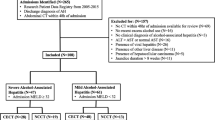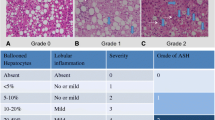Abstract
Purpose
To evaluate the prognostic value of abdominal computed tomography (CT) in patients with alcoholic hepatitis (AH).
Methods
This ancillary study was based on data collected during a previous randomized controlled trial in patients with AH. Clinical response was defined as the improvement of the baseline MELD score ≥3 points at 3 months. All patients underwent contrast-enhanced CT of the abdomen. The following parameters were measured: (1) liver density, spleen density, and liver-to-spleen density ratio; (2) liver-to-body weight (LBW) ratio; and (3) subcutaneous fat, visceral fat, and muscular content. Improvers and non-improvers were compared with univariate, multivariate, and ROC analyses. Results were compared with a validation cohort of patients.
Results
Fifty-eight patients (mean age, 56 years) were analyzed, including 34 (59 %) improvers. On multivariate analysis, LBW ratio (OR = 3.73; 95 % CI, 1.65–8.46; p = 0.002) and subcutaneous fat (OR = 1.01; 95 % CI, 1.00–1.02; p = 0.022) were associated with clinical response, with AUROC curves of 0.78 ± 0.06 (p < 0.001) and 0.66 ± 0.07 (p = 0.043), respectively. LBW ≥2.4 % predicted response with 88 % sensitivity and 63 % specificity. In the validation cohort (n = 42, 64 % improvers), the same cut-off value predicted response with 93 % sensitivity and 60 % specificity.
Conclusions
In patients suffering from AH, the liver volume appears to be a major positive prognostic factor.

Similar content being viewed by others
Abbreviations
- AH:
-
Alcoholic hepatitis
- ASH:
-
Alcoholic steatohepatitis
- AUROC:
-
Area under the receiver-operator characteristic curve
- CI:
-
Confidence intervals
- CT:
-
Computed tomography
- LBW:
-
Liver-to-body weight
- MRI:
-
Magnetic resonance imaging
- OR:
-
Odds ratio
- ROI:
-
Region of interest
References
European Association for the Study of Liver (2012) EASL clinical practical guidelines: management of alcoholic liver disease. J Hepatol 57:399–420
Liangpunsakul S (2011) Clinical characteristics and mortality of hospitalized alcoholic hepatitis patients in the United States. J Clin Gastroenterol 45:714–719
Gao B, Bataller R (2011) Alcoholic liver disease: pathogenesis and new therapeutic targets. Gastroenterology 141:1572–1585
Mathurin P, Mendenhall CL, Carithers RL, et al. (2002) Corticosteroids improve short-term survival in patients with severe alcoholic hepatitis (AH): individual data analysis of the last three randomized placebo controlled double blind trials of corticosteroids in severe AH. J Hepatol 36:480–487
Lucey MR, Mathurin P, Morgan TR (2009) Alcoholic hepatitis. N Engl J Med 360:2758–2769
Lee YJ, Lee JM, Lee JS, et al. (2015) Hepatocellular carcinoma: diagnostic performance of multidetector CT and MR imaging—a systematic review and meta-analysis. Radiology 275:97–109
Lim MC, Tan CH, Cai J, Zheng J, Kow AWC (2014) CT volumetry of the liver: where does it stand in clinical practice? Clin Radiol 69:887–895
Iranmanesh P, Vazquez O, Terraz S, et al. (2014) Accurate computed tomography-based portal pressure assessment in patients with hepatocellular carcinoma. J Hepatol 60:969–974
Cruz RJ, Dew MA, Myaskovsky L, et al. (2013) Objective radiologic assessment of body composition in patients with end-stage liver disease: going beyond the BMI. Transplantation 95:617–622
Shores NJ, Link K, Fernandez A, et al. (2011) Non-contrasted computed tomography for the accurate measurement of liver steatosis in obese patients. Dig Dis Sci 56:2145–2151
Luo XF, Xie XQ, Cheng S, et al. (2015) Dual-energy CT for patients suspected of having liver iron overload: can virtual iron content imaging accurately quantify liver iron content? Radiology. doi:10.1148/radiol.2015141856
Lamb P, Sahani DV, Fuentes-Orrego JM, et al. (2015) Stratification of patients with liver fibrosis using dual-energy CT. IEEE Trans Med Imaging 34:807–815
Ronot M, Asselah T, Paradis V, et al. (2010) Liver fibrosis in chronic hepatitis C virus infection: differentiating minimal from intermediate fibrosis with perfusion CT. Radiology 256:135–142
Spahr L, Chalandon Y, Terraz S, et al. (2013) Autologous bone marrow mononuclear cell transplantation in patients with decompensated alcoholic liver disease: a randomized controlled trial. PLoS One 8:e53719
Malinchoc M, Kamath PS, Gordon FD, et al. (2000) A model to predict poor survival in patients undergoing transjugular intrahepatic portosystemic shunts. Hepatology 31:864–871
Dominguez M, Rincón D, Abraldes JG, et al. (2008) A new scoring system for prognostic stratification of patients with alcoholic hepatitis. Am J Gastroenterol 103:2747–2756
Spahr L, Rubbia-Brandt L, Pugin J, et al. (2001) Rapid changes in alcoholic hepatitis histology under steroids: correlation with soluble intercellular adhesion molecule-1 in hepatic venous blood. J Hepatol 35:582–589
Altamirano J, Miquel R, Katoonizadeh A, et al. (2014) A histologic scoring system for prognosis of patients with alcoholic hepatitis. Gastroenterology 146:1231–1239
Lee JY, Kim TY, Jeong WK, et al. (2014) Clinically severe portal hypertension: role of multi-detector row CT features in diagnosis. Dig Dis Sci 59:2333–2343
Maruzzelli L, Parr AJ, Miraglia R, Tuzzolino F, Luca A (2014) Quantification of hepatic steatosis: a comparison of computed tomography and magnetic resonance indices in candidates for living liver donation. Acad Radiol 21:507–513
van der Vorst JR, van Dam RM, van Stiphout RSA, et al. (2010) Virtual liver resection and volumetric analysis of the future liver remnant using open source image processing software. World J Surg 34:2426–2433
Tan BHL, Birdsell LA, Martin L, Baracos VE, Fearon KCH (2009) Sarcopenia in an overweight or obese patient is an adverse prognostic factor in pancreatic cancer. Clin Cancer Res 15:6973–6979
Mitsiopoulos N, Baumgartner RN, Heymsfield SB, et al. (1998) Cadaver validation of skeletal muscle measurement by magnetic resonance imaging and computerized tomography. J Appl Physiol 85:115–122
Prado CMM, Lieffers JR, McCargar LJ, et al. (2008) Prevalence and clinical implications of sarcopenic obesity in patients with solid tumours of the respiratory and gastrointestinal tracts: a population-based study. Lancet Oncol 9:629–635
Mathurin P, O’Grady J, Carithers RL, et al. (2011) Corticosteroids improve short-term survival in patients with severe alcoholic hepatitis: meta-analysis of individual patient data. Gut 60:255–260
Louvet A, Naveau S, Abdelnour M, et al. (2007) The Lille model: a new tool for therapeutic strategy in patients with severe alcoholic hepatitis treated with steroids. Hepatology 45:1348–1354
Spahr L, Rubbia-Brandt L, Genevay M, Hadengue A, Giostra E (2011) Early liver biopsy, intraparenchymal cholestasis, and prognosis in patients with alcoholic steatohepatitis. BMC Gastroenterol 11:115–124
Kojima HI, Sakurai S, Uemura M, et al. (2005) Difference and similarity between non-alcoholic steatohepatitis and alcoholic liver disease. Alcohol Clin Exp Res 29:259–263
Costa Matos L, Batista P, Monteiro N, et al. (2013) Iron stores assessment in alcoholic liver disease. Scand J Gastroenterol 48:712–718
Bohte AE, Werven JR, Bipat S, Stoker J (2010) The diagnostic accuracy of US, CT, MRI and 1H-MRS for the evaluation of hepatic steatosis compared with liver biopsy: a meta-analysis. Eur Radiol 21:87–97
Israel Y, Orrego H, Colman JC, Britton RS (1982) Alcohol-induced hepatomegaly: pathogenesis and role in the production of portal hypertension. Fed Proc 41:2472–2477
Awaya H, Mitchell DG, Kamishima T, et al. (2002) Cirrhosis: modified caudate-right lobe ratio. Radiology 224:769–774
Torres WE, Whitmire LF, Gedgaudas-McClees K, Bernardino MEJ (1986) Computed tomography of hepatic morphologic changes in cirrhosis of the liver. Comput Assist Tomogr 10:47–50
Goodman ZD, Ishak KG (1982) Occlusive venous lesions in alcoholic liver disease. A study of 200 cases. Gastroenterology 83:786–796
Montano-Loza AJ, Meza-Junco J, Prado CMM, et al. (2012) Muscle wasting is associated with mortality in patients with cirrhosis. Clin Gastroenterol Hepatol 10:166–173
Periyalwar P, Dasarathy S (2012) Malnutrition in cirrhosis: contribution and consequences of sarcopenia on metabolic and clinical responses. Clin Liver Dis 16:95–131
Hanai T, Shiraki M, Nishimura K, et al. (2015) Sarcopenia impairs prognosis of patients with liver cirrhosis. Nutrition 31:193–199
Giusto M, Lattanzi B, Albanese C, et al. (2015) Sarcopenia in liver cirrhosis: the role of computed tomography scan for the assessment of muscle mass compared with dual-energy X-ray absorptiometry and anthropometry. Eur J Gastroenterol Hepatol 27:328–334
Klöting N, Blüher M (2014) Adipocyte dysfunction, inflammation and metabolic syndrome. Rev Endocr Metab Disord 15:277–287
Naveau S, Dobrin AS, Balian A, et al. (2012) Body fat distribution and risk factors for fibrosis in patients with alcoholic liver disease. Alcohol Clin Exp Res 37:332–338
Choi PC, Kim HJ, Choi WH, et al. (2009) MELD, sodium and Child scores over time for the prediction of complications of liver cirrhosis. Liver Int 29:221–226
Author information
Authors and Affiliations
Corresponding author
Ethics declarations
Funding
This study has been financially supported by the Clinical Research Center, University Hospital and Faculty of Medicine, Geneva, and the Louis-Jeantet Foundation, and FLAGS (Foundation for Liver and Gut Studies in Geneva), and la Loterie Romande. The funders had no role in study design, data collection and analysis, decision to publish, or preparation of the manuscript.
Conflict of interest
The authors declare that they have no conflict of interest.
Ethical approval
All procedures performed in this study involving human participants were in accordance with the ethical standards of the institutional research committee and with the 1964 Helsinki declaration and its later amendments.
Informed consent
Informed consent was obtained from all individual participants included in the study.
Rights and permissions
About this article
Cite this article
Breguet, R., Ronot, M., Goossens, N. et al. Liver volume is a prognostic indicator for clinical outcome of patients with alcoholic hepatitis. Abdom Radiol 42, 460–467 (2017). https://doi.org/10.1007/s00261-016-0892-7
Published:
Issue Date:
DOI: https://doi.org/10.1007/s00261-016-0892-7




